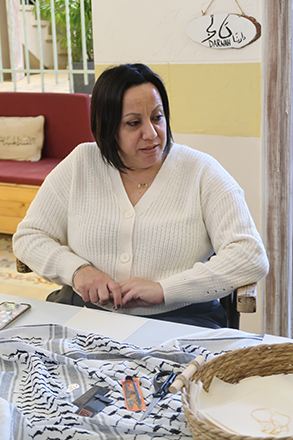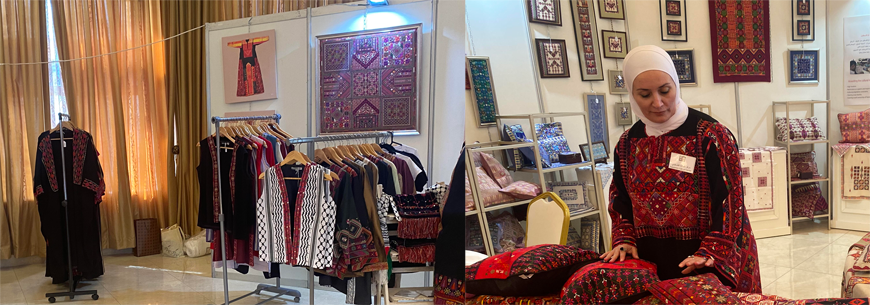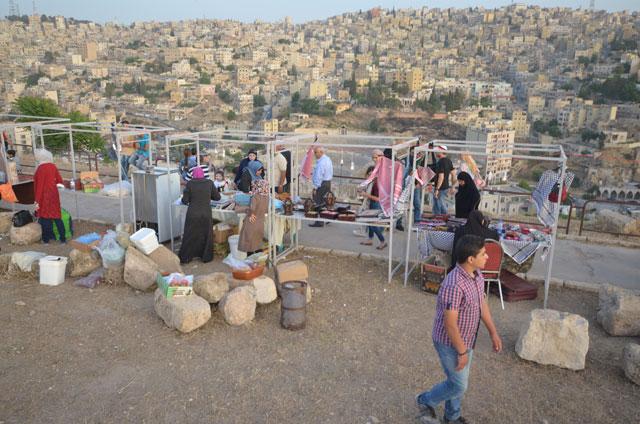You are here
Generations of Palestinian embroiderers weave a tale of identity, perseverance
By Ladin Akcacioglu - Aug 11,2022 - Last updated at Aug 11,2022

Left: Palestinian thobes are seen in a shop in downtown Amman. Right: A traditional Palestinian thobe from the collection of Widad Kawar on display at Tiraz Centre (Photos by Ladin Akcacioglu)
AMMAN — For Mervat Badvan, a Palestinian embroiderer in Baqaa refugee camp, traditional Palestinian cross-stich “tatreez” must be passed down to later generations to ensure its survival.
Tatreez, considered unmatched in its ability to record intergenerational stories of Palestinian tradition and society, was recognised as an Intangible Cultural Heritage by UNESCO in 2021.
Mervat’s daughter Laian is an 11th grader at a local high school and has been learning the art since she was in 4th grade.
“When I have kids, I will teach them too because I want to keep my heritage alive,” Laian said.
“If she doesn’t, I will teach my grandchildren,” Mervat remarked.
Though Mervat’s family is originally from Gaza, she was born and raised in Baqaa, an “emergency” camp created by UNRWA following the catastrophic displacement of Palestinians as a result of the 1967 Israeli invasion.
Mervat’s mother was among the refugees who arrived at Baqaa to build a permanent home in temporary exile.
It was in Baqaa that Mervat learned tatreez from her mother at the age of 10. In addition to connecting to her Palestinian roots, tatreez is now a source of income for Mervat’s family.
Mervat works for the Kushtban Initiative, a small tatreez business that was founded by Ali Hamdan and his spouse Ansaam Hajeer in 2020.
According to Hamdan, Kushtban aims “to ensure the survival of tatreez, as its continuation is the only way to resist the occupation and the Israeli cultural erasure”.
Though the increased global awareness of tatreez has positively impacted its survival, its “commodification” does not always translate into fair wages for its female creators, Mervat said.
“Once, I worked for an organisation and made them a keffiyeh which took a year to make... they paid me $1100 and sold it at an auction for 40,000 dollars,” she said.
At fair wages, “handmade tatreez costs are significantly higher compared with machine-made tatreez,” she said.
Rami Al Qais, a shop owner in downtown Amman, has sold tatreez for over 30 years.
“Currently, handmade tatreez is a rare skill. Mostly elderly women who had picked up the skill from their mothers still know the craft,” said Qais.
According to Qais, like most other tatreez shops in downtown Amman, almost all of the tatreez thobes in his shop are machine-made.
Handmade thobes start from JD200 and can reach thousands, whereas, fully machine-made thobes range between JD15-50, the shop owner said.
According to Ruba Al Thaher, a Palestinian researcher, the occupation and the consecutive forced displacement of Palestinians have disrupted the natural transmission of the craft.
Thaher is the current curator of Tiraz Centre the home to the largest existing collection of Arab clothing by Widad Kawar.
Due to the occupation, “Palestinian women who once wore very intricate dresses were forced to sell their thobes to buy basic living necessities. They could no longer afford the tatreez supplies which they once acquired from hand weavers in Palestine,” Thaher said.
In the 1960s, “machine-made replicas started to enter the market” because the hand-weavers in Palestine could no longer produce the demanded supply, she explained.
Following the 1967 war, many Palestinian refugee embroiderers in Jordan were forced to swap their traditional tatreez thobes in exchange for more lucrative products, such as cushions, bags and wallets.
In commercialising their ancestral craft, many Palestinian communities were able to sustain themselves and build a life in Jordan, Thaher said.
Currently, the minimum wage in Jordan is set to JD260, which makes traditional handmade thobes a luxury item for the general public.
Tatreez remains a vital source of income for many refugee women in Jordan, with many NGOs working diligently to ensure the tradition’s survival.
“Tatreez itself is just a needle and a string and it doesn’t need protection… what needs to be protected is the people who have the skills to make tatreez,” said Rami.
Related Articles
AMMAN — At the heart of Palestinian culture lies a rich tapestry of traditions that have endured the test of time.
AMMAN — The annual Palestinian Cultural Exhibition, organised by the Palestinian Cultural Centre (PCC), kicked off on Thursday und
AMMAN — Although Haifa Odwan does not make handicraft products, she decided to take part in a bazaar at the Amman Citadel to promote her nei
















